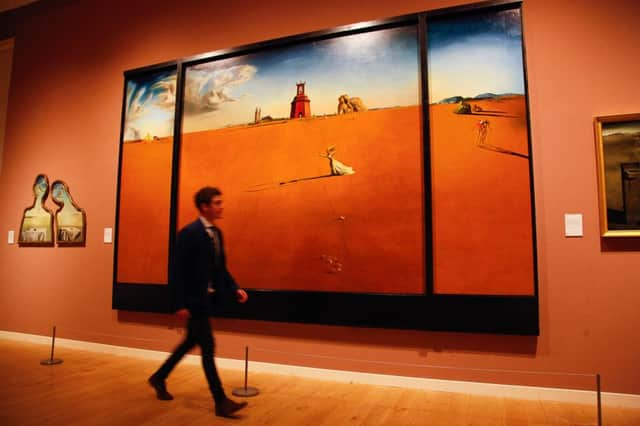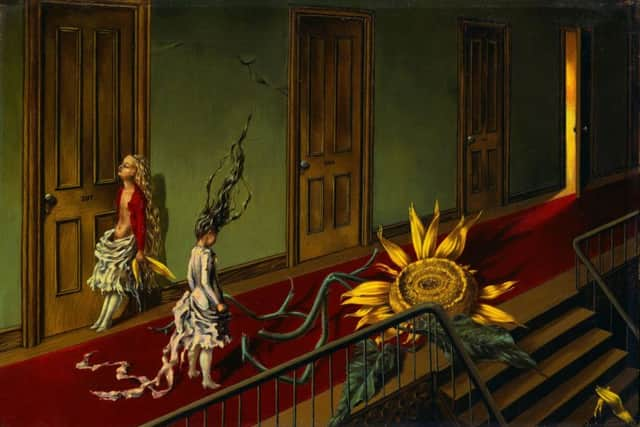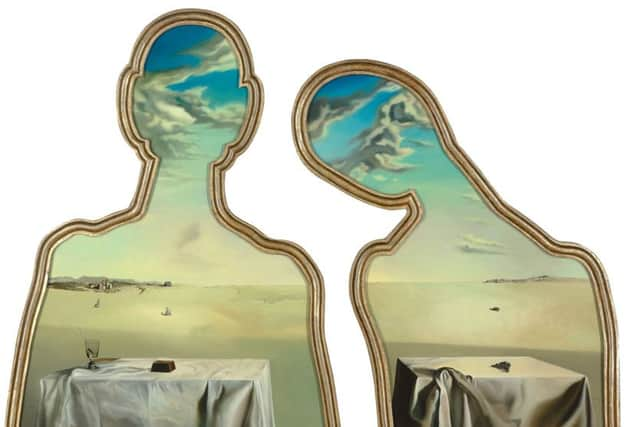Art review: Surreal Encounters, Scottish National Gallery of Modern Art


Surreal Encounters: Collecting the Marvellous | Rating: *** | Scottish National Gallery of Modern Art, Edinburgh
In 1938, when the Surrealist group of artists exhibited together at the Galerie Beaux-Arts in Paris, the artist Marcel Duchamp hung 1,200 newspaper-stuffed coal sacks from the ceiling. Coal dust trickled onto the viewers below. Wolfgang Paalen had installed a pond with real lilies and reeds, so the atmosphere was dark and soggy. On the dim opening night visitors stumbled around ankle deep in leaves, looking at the work with torches.
Advertisement
Hide AdAdvertisement
Hide AdIn 1942, as the Surrealists marked their wartime exile in New York, Duchamp wound an entire exhibition space with miles of twine. It either prevented people from getting near the exhibits, or dictated precisely which views they had of the proceedings. It was, amongst other things, an elaborate joke on André Breton, the stern godfather and po-faced chief enforcer of Surrealism – he was Duchamp’s “ficelle” (his “string” or decoy in crime). Duchamp even hired local children to deliberately get in the way of posh visitors on the opening night, playing hopscotch and basketball games in the exhibition space.


All of this goes some way to showing just how hard it might be for a modern museum, with its rules and its responsibilities, to capture the irreverent atmosphere of Surrealism, now that the movement’s great works are as rarefied, researched, and as expensive, as old masters. These days Surrealism is not an epoch-shaking subversion or an elite intellectual game but an everyday coinage. And the works on show in Edinburgh this summer, from Salvador Dalí’s distorted technicolour fantasies to Magritte’s suburban subversion the stuff of mainstream visual culture.
At Surreal Encounters: Collecting the Marvellous, this year’s blockbuster at the Scottish National Gallery of Modern Art, you can leave the children to play games outside in a special children’s playground entitled Surreal Adventures, where they can have a picnic on a wobbly bench or sit on a concrete chesterfield. But once you are in, you must behave. There is on show an example of the most famous sofa in the history of comfortable seating, the Salvador Dali/Edward James editioned plush pink pouffe shaped like Mae West’s lips for Schiaparelli’s couture showroom. One used to sit in the window of the furniture dealer next door to the gallery in Paris and people could lounge on it before they saw the show. Now of course it is firmly under glass. Then there’s one of those famous lobster telephones. These days it rings for no one.
The show, which is a partnership with museums in Rotterdam and Hamburg, is gargantuan. It brings together nearly 400 objects: paintings, sculpture, publications and archive materials that in their sheer scale and number are jaw-dropping. The artists are a tick list of Surrealism’s biggest boys and their fellow travellers: there are important works by Salavador Dalí, René Magritte, Giorgio de Chirico, André Breton, Man Ray, Max Ernst, Yves Tanguy and Paul Delvaux. Picasso, who was never a surrealist, served as an éminence grise. The Dadaist Duchamp, who belonged in a category of one, is the mischievous uncle of the movement, ally one moment, provocateur the next.
The works are sourced from four major collections. Two historic collections now dispersed are those of the British collector Roland Penrose and the Anglo-American railroad heir Edward James. Then there are the wealthy German collectors Ulla and Heiner Pietzsch who have collected since 1972 and the late Gabrielle Keiller, who by virtue of her Scottish connections including marriage to the scion of the Dundee marmalade family and an intimate friendship with the Scots Italian sculptor Eduardo Paolozzi, became an adviser to the Scottish National Gallery of Modern Art and bequeathed her collection to it in 1995.


Each collector’s sensibility brings something unique. The earnest Quaker Roland Penrose met Surrealism through his friendship with poets and painters. When the poet Paul Eluard went bust he helped him out by acquiring 40 Ernsts, ten Picassos and a heap of other stuff for £1,000. James brought a camp, joyful decorator’s sensibility to the enterprise. He hired artists to decorate his home and the family seat West Dean in Sussex. James liked to think of himself as a collaborator but he was a commissioner and with his pale and pinched look he was also a muse of sorts. Man Ray photographed him with a blinding ball of light for a head, Magritte pictured him facing a mirror which eerily reflects not his face but the back of his head.
The Pietzch’s are described as methodical. The works they have acquired are sometimes startlingly good, eerily clean and tell us about Surrealism’s modern reception and its respectable sanitisation. Keiller collected Dada and Surrealism with the pop art sensibility she learned at Paolozzi’s side, and an emphasis on the erotic, collage and works on paper. Both Penrose and James were much better on the female artists associated with the movement – there are excellent works by Leonora Carrington (a lifelong friend of James), Dorothea Tanning and Leonor Fini that tell of another surrealism altogether.
Advertisement
Hide AdAdvertisement
Hide AdThere is, however, something ultimately unsatisfactory about this as a lens for an exhibition of such scale and such riches. Surreal Encounters is a show packed with information but somehow short on ideas. One longs for a story, a good argument, some art historical or visual mischief. Most visitors, however, will come for the monsters of the movement and the central gallery displaying the major works by Dalí and Magritte’s huge painting of a foot/boot hybrid, The Red Model III. It’s a spectacle. But it makes you long for an age when encountering Surrealism was also spectacular fun.
• Until 11 September